#tutankhamun curse
Text
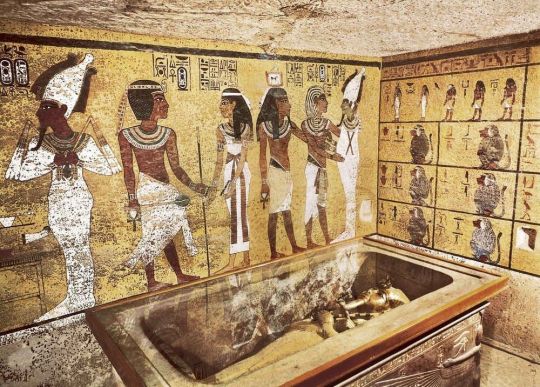
‘Curse’ Behind King Tutankhamun’s Tomb Mysterious Deaths Finally Solved
The unsettling curse of King Tutankhamun’s tomb in Egypt has bewildered archaeologists since it’s been feared to be linked to the mysterious deaths of multiple excavators who discovered it in 1922.
However, a scientist now claims to have solved the mysteries of the infamous “Pharaoh’s Curse” more than 100 years later.
Toxic levels of radiation emanating from uranium and poisonous waste are believed to have lingered inside the tomb since it was sealed over 3,000 years ago, Ross Fellowes wrote last month in the Journal of Scientific Exploration (JSE).

The burial chamber in the tomb of Tutankhamun, near Luxor, Egypt.
The radiation level inside Tutankhamun’s tomb is so high that anyone who comes in contact with it could very likely develop a fatal dose of radiation sickness and cancer.
“Both contemporary and ancient Egypt populations are characterized by unusually high incidences of hematopoietic cancers, of bone/blood/lymph, for which a primary known cause is radiation exposure,” Fellowes wrote in his study.
However, this radioactivity isn’t isolated to Tutankhamun’s tomb.
Fellowes revealed that “unusually high radiation levels have been documented in Old Kingdom tomb ruins” and spread throughout sites in Egypt.
“Radiation has been detected by the Geiger counter at two sites at Giza adjacent to the pyramids,” he wrote, adding that radon — a radioactive gas — has also been detected in “several underground tombs at Saqqara.”
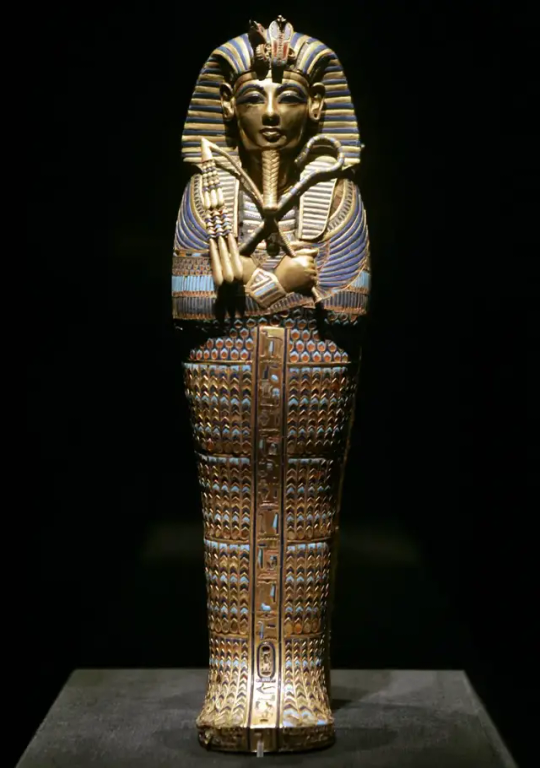
The “Coffinette for the Viscera of Tutankhamun,” which contained the king’s mummified liver, depicts him as Osiris, holding a crook and flail.

Medical imagery of Tutankhamun is shown above a replica of King Tut’s skull on display during the “Tutankhamun And The Golden Age Of The Pharaohs” at the Los Angeles County Museum of Art in California.
These readings were all found to be “intensely radioactive.”
“Modern studies confirm very high levels of radiation in ancient Egyptian tombs, in the order of 10x accepted safety standards,” the study shared.
It’s also theorized that those who built the ancient tombs were aware of the toxins based on the eerie warnings carved on the walls.
“The nature of the curse was explicitly inscribed on some tombs, with one translated presciently as, ‘they that break this tomb shall meet death by a disease that no doctor can diagnose,’” Fellowes wrote.
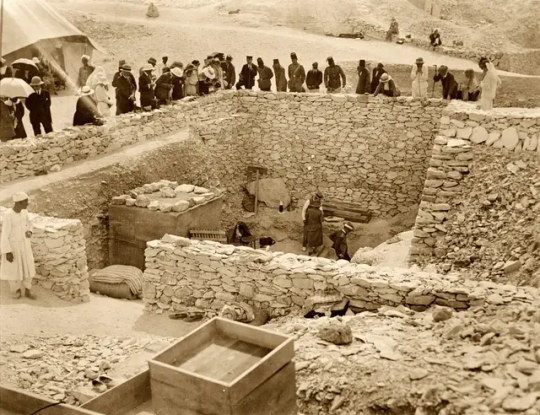
Outside the tomb of Tutankhamun during the 1922 excavation in the Valley of the Kings in Egypt.
Other ominous translations like “forbidden” because of “evil spirits” may have significantly fueled the fear that supernatural curses lingered in the ancient sites.
Those fears intensified with the mysterious deaths of Lord Carnarvon, who funded the excavation in 1922 and reportedly walked through the treasured filled rooms — and multiple others after they unsealed the tomb.
“Carnarvon was dead within a few weeks of the uncertain diagnosis of blood poisoning and pneumonia,” Fellowes wrote.
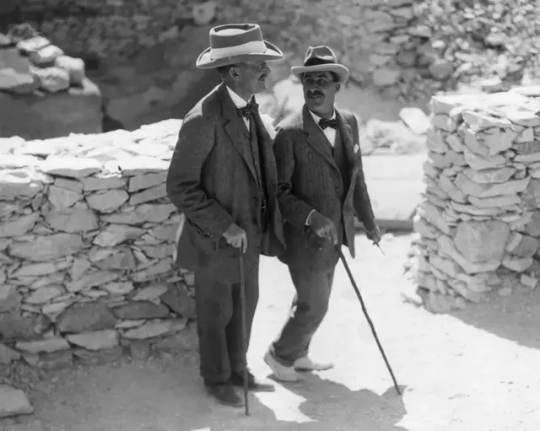
Egyptologist Howard Carter (R) walks with archaeologist Lord Carnarvon, the patron of his research, outside the tomb of King Tutankhamun in 1922.
Egyptologist Arthur Weigall allegedly told colleagues that Carnarvon would “be dead within six weeks” upon entering, the study claimed.
Howard Carter, the first person to walk inside Tutankhamun’s tomb with Carnarvon, died in 1939 after a long battle with Hodgkin’s lymphoma, which was suspected to be caused by radiation poisoning.
British Egyptologist and independent excavator Arthur Weigall was present at the opening of Tut’s Tomb and is also credited with starting the ‘myth’ of the curse.
He died of cancer at 54 years old in 1934.
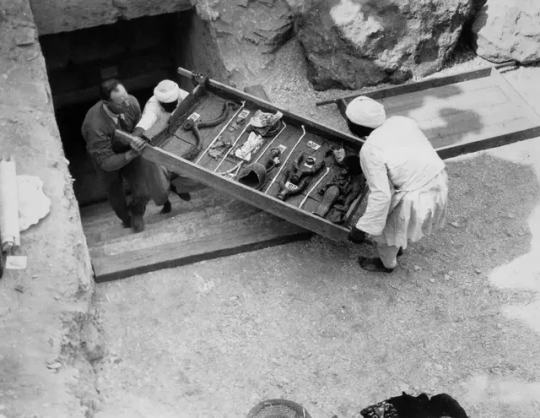
Workers remove a tray of chariot parts from the Tomb of Tutankhamun in the Valley of the Kings, Egypt, in 1922.
In total, six of the 26 people present when the tomb was opened died within a decade from asphyxia, stroke, diabetes, heart failure, pneumonia, poisoning, malaria and X-ray exposure.
While the deaths can be seen as odd, the curse theory was also likely fueled by the oddities that happened when it opened.
Carnarvon had reportedly suffered a mosquito bite that became severely infected.
Around the time excavators opened the tomb, Cairo reportedly suffered a bizarre power outage and a freak sandstorm, according to National Geographic.’
At one point during the excavation, Carnarvon’s favorite dog allegedly let out a chilling howl and suddenly dropped dead.
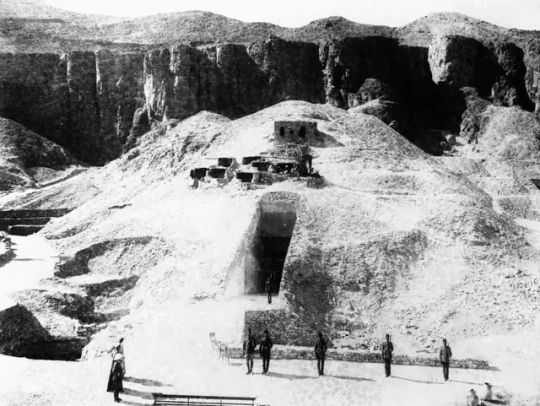
A photograph showing guards standing outside the tomb of Tutankhamun in Egypt in 1922.

A sacred cow being removed from Tomb of Tutankhamun in 1922.
From a historical perspective, the discovery of the tomb in the Valley of Kings is considered one of the most fascinating finds that gave modern society a glimpse into the Egyptian royalty voyage into the afterlife.
Five thousand items, including solid gold funeral shoes, statues, games, and strange animals, were discovered inside Tutankhamun’s tombs.
It would take the excavators ten years to clear the tomb of its treasure.
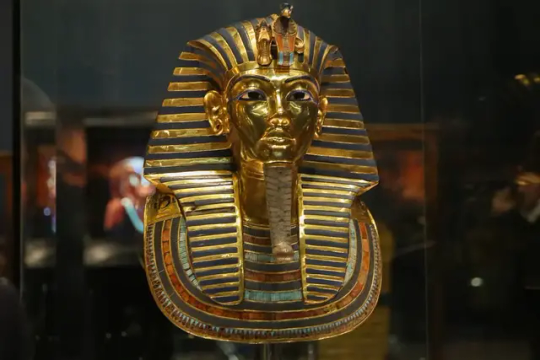
The golden funerary mask of Tutankhamun.
The unsealing and studying of the tomb is also credited with launching the modern era of Egyptology.
Tutankhamun took the throne as pharaoh around nine or ten years old and ruled between 1332 BC and 1323 BC.
However, he died by the time he turned 18.
There are no surviving records of Tutankhamun’s death and how the young pharaoh died remains a mystery.
However, Tutankhamun is suspected to have suffered from several health issues — likely linked to his father, Akhenaten, and his mother, Nefertiti, being brother and sister.
By Richard Pollina.
#‘Curse’ Behind King Tutankhamun’s Tomb Mysterious Deaths Finally Solved#King Tutankhamun#Pharaoh’s Curse#Old Kingdom#Valley of the Kings#Lord Carnarvon#Howard Carter#Egyptology#ancient artifacts#archeology#archeolgst#history#history news#ancient history#ancient culture#ancient civilizations#ancient egypt#egyptian history#egyptian mythology#egyptian pharaoh#egyptian antiquities#egyptian art
72 notes
·
View notes
Text
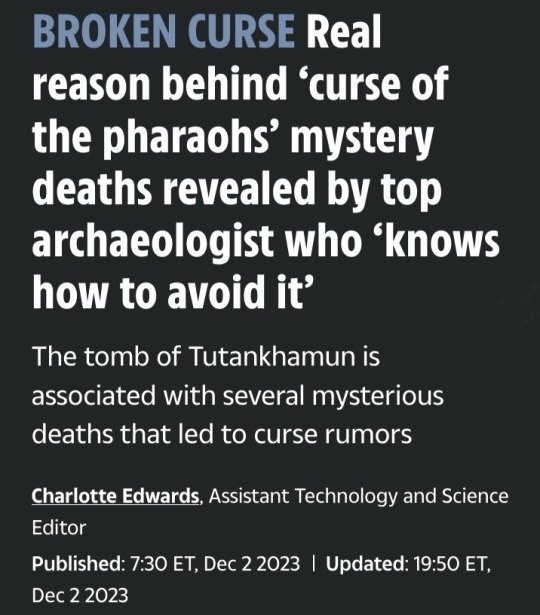
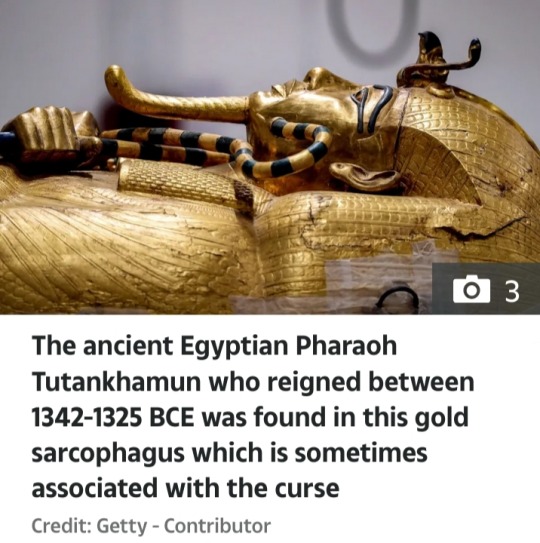
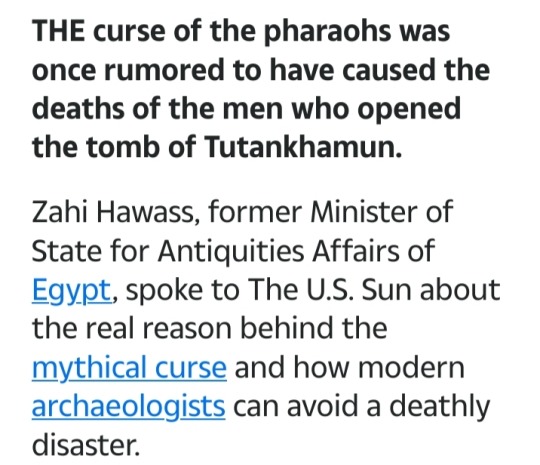
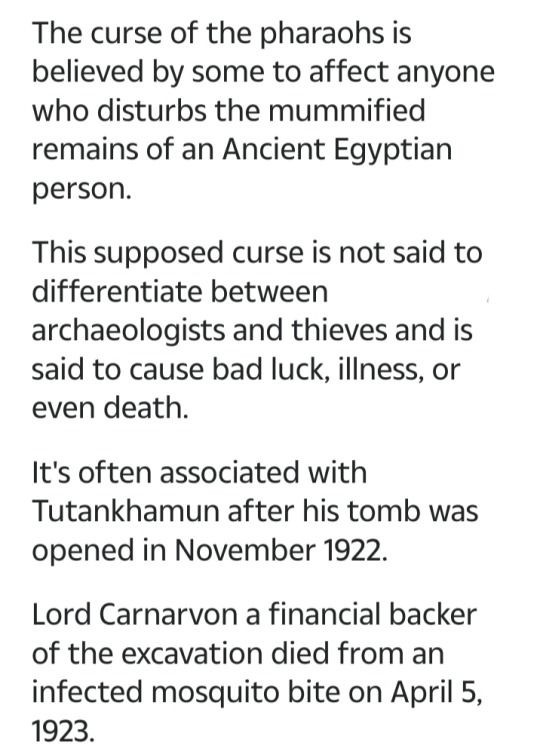
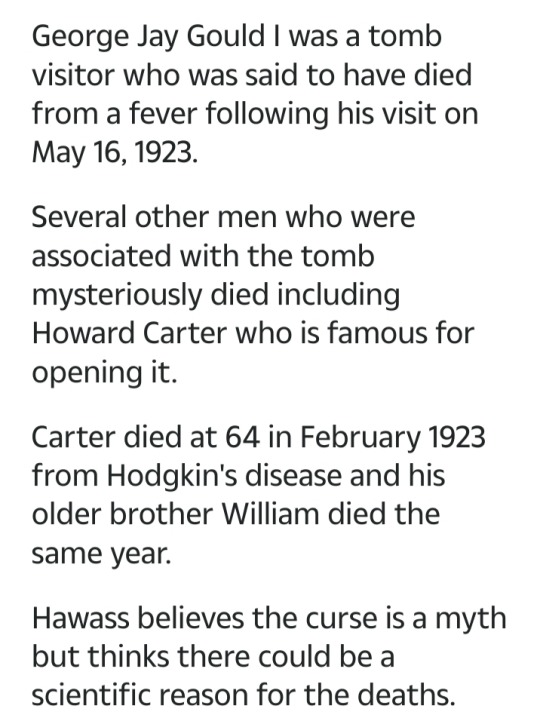
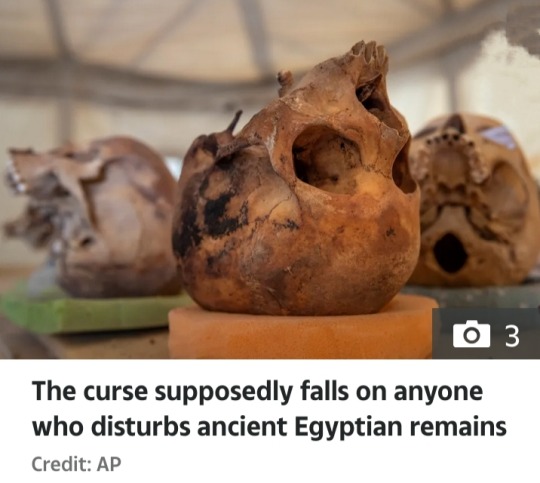
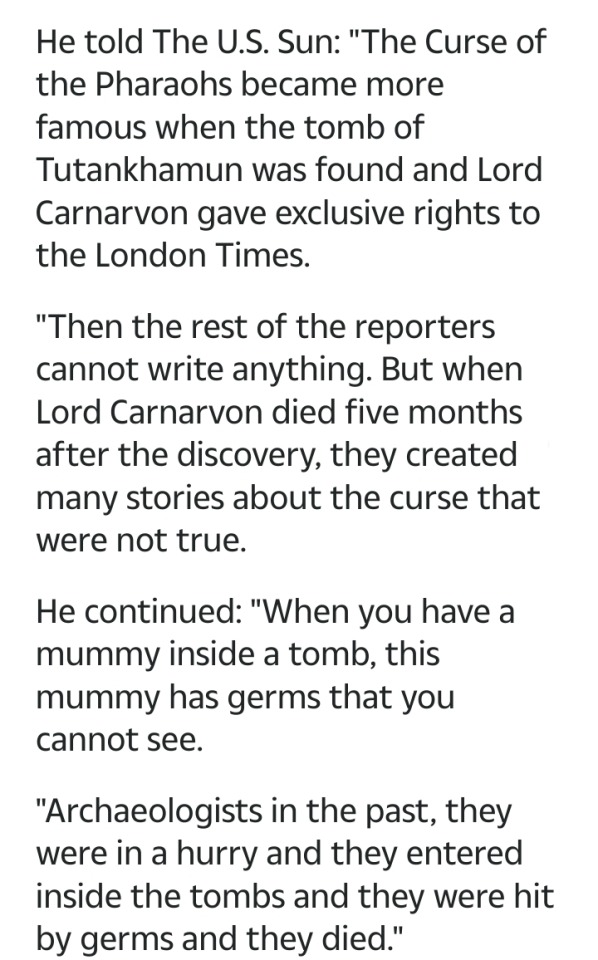
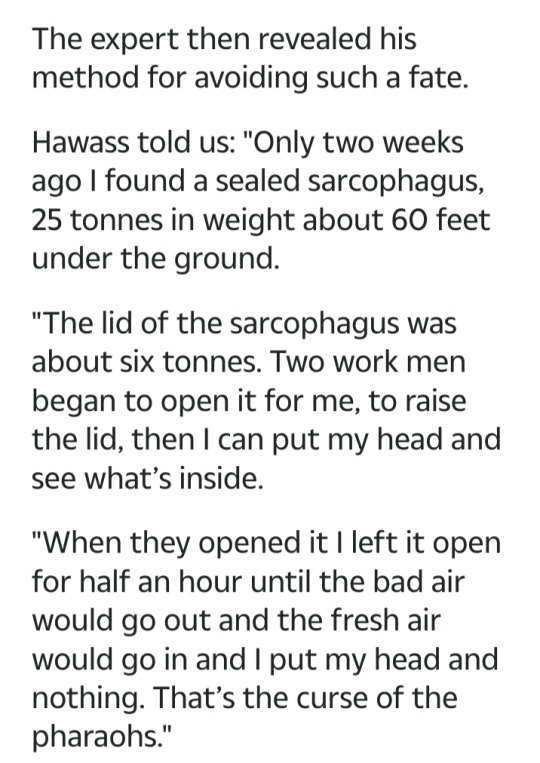

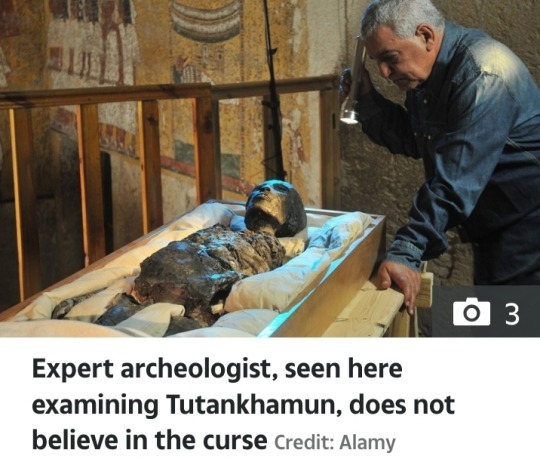
#Tutankhamun#Tomb of Tutankhamun#curse of the pharaohs#Ancient Egypt#Ancient Civilization#Dr Zahi Hawass#Minister of State for Antiquities Affairs#Egypt#mythical curse#archaeology#sarcophagus#mummified remains#Lord Carnarvon#Howard Carter#George Jay Gould I#mummies#germs#curse#Ancient Egyptian Pharaoh
60 notes
·
View notes
Text



my reimagining of Tutankhamen from Sphinx and the Cursed Mummy. thought he could use a sweet helm for security reasons.
59 notes
·
View notes
Text
imagine trying to casually use the bathroom and then Tutankhamun just goes:
PHARAOHS CURSE, DAMN THIS MAN, TURN HIS TOILET INTO SAND
and then your day is ruined :(
12 notes
·
View notes
Text


ℌ𝔬𝔴𝔞𝔯𝔡 ℭ𝔞𝔯𝔱𝔢𝔯 𝔢𝔵𝔞𝔪𝔦𝔫𝔦𝔫𝔤 𝔱𝔥𝔢 𝔦𝔫𝔫𝔢𝔯𝔪𝔬𝔰𝔱 𝔠𝔬𝔣𝔣𝔦𝔫 𝔬𝔣 𝔗𝔲𝔱𝔞𝔫𝔨𝔥𝔞𝔪𝔲𝔫 𓋹𓂀
#Howard Carter#examining#coffin#Tutankhamun#tomb#pharaohs#pharaoh#casket#sarcophagus#curse of the pharaohs#tutankhamun#tutankamon#b&w#colorized#colorful
59 notes
·
View notes
Text




#you have no idea how much i had to dance around to get these photos without dying#ac:og#ac: origins#curse of the pharaohs#akhenaten#nefertiti#tutankhamun#ramesses ii
11 notes
·
View notes
Photo

“I’ve gotta do something! He’s getting worse!”
#original#PLEASE don't let this flop i spent so long on it#lupin iii#lupin red jacket#lupin iii part 2#arsene lupin iii#tutankhamun's 3000 year curse#cursed case scenario#lupin iii fanart#grimey art
13 notes
·
View notes
Text
Deadly fall: The mummy’s curse
THE MUMMY’S CURSE
Category: Egyptomania / Urban legends / Egyptian belief
When I say “mummy”, you say “curse”. It is part of popular culture: everybody knows that if you open the tomb of a mummy or disturb the corpse of ancient Egyptian ruler, a curse will fall upon you. I can’t count the number of movies, novels and short stories that use mummies as supernatural forces and vengeful undead preying on those that desecrated their eternal rest. But what started this trend? What caused the apparition of this trope in medias? Well, it was a very mediatized case that is still well-known to us today: the curse of Tutankhamun.
In 1922, an event shook the world of archeology, and shaped Egyptology forever: the now famous archeologist Howard Carter discovered and open the tomb of the pharaoh Tutankhamun. It was a world-turning event that marked history… and it was also an event that was soon rumored to have unleashed a curse.
The first incident of the “curse” was actually reported in December 1922 (the tomb having been opened the previous month) by an Egyptologist, James Henry Breasted, a co-worker of Carter. He recalled to a newspaper how after opening the tomb, Carter sent someone to his house to send a message – and upon arriving the messenger heard a cry that he would describe as “faint but almost human-like”. Upon entering the house, the messenger saw that a cobra had broken into the birdcage of Carter’s canary-pet: the snake was still in the cage, with the bird’s corpse in its mouth. Now this incident mostly bothered the “locals” and the “superstitious”: you see, the snake, especially the cobra, was the symbol of the Egyptian pharaohs. It was the “uraeus”, the snake pharaohs wore on their crown, and which was supposed to come to live if the king was ever threatened – the cobra would spit poison on fire on the aggressor. Similarly, cobra-headed goddesses were charged with protecting the person of the pharaoh. As a result, seeing a cobra sneak into the house of the archeologist and killing his pet was interpreted as a sign, or a vengeance – especially since the snake broke into the house the same day Carter broke into the Pharaoh’s tomb, his “eternal house”.
However there was no real talk of a “curse”. The “curse” only began on April 1923 upon the death of Lord Carnarvon. Of his full name George Herbert, Fifth Earl of Carnarvon, he was the man who had financed Carter’s expedition and the exploration of the tomb. He got a nasty mosquito bite in Egypt, which he later slashed by accident when shaving: this led to a blood poisoning which left him gravely sick. During his sickness, the novelist Marie Corelli wrote a letter that was published in the New York World newspaper, in which she explained how it was said and believed that anyone who intruded a sealed Egyptian tomb would suffer a “dire punishment”: two weeks after the letter was written, Lord Carnarvon died. His death, coupled with the letter, couple with the canary incident, led to a huge mediatization of the “curse of Tutankhamun”: all the newspapers wrote about how the curse that had been found inscribed in the tomb, promising punishment to all those who would desecrate the grave, had made its “first victim”. It got so big that Benito Mussolini himself (yes, THE WW2 dictator), who was quite superstitious, asked the Egyptian mummy he had stored in the Chigi Palace to be removed immediately. Fuel was added to the fire by Sir Arthur Conan Doyle, who beyond his novelist activity was a very active paranormal enthusiast dabbling in Spiritism, and he studied the case of the “curse”, even publicly making the theory that the Earl had been killed by elemental spirits that were set to guard the tomb by ancient Egyptian priests. And when the corpse of Tutankhamun was autopsied, it was found that the mummy had a lesion on the left cheek – which was equated by media with the mosquito bite that killed Carnarvon (however the corpse of the Earl was never dug-up to verify if the two heals matched).
The curse struck three more times. First “victim”, professor La Fleur, a Canadian archeologist and close friend of Carter. Second “victim”: a railroad financier known as George Jay Gould the First: on May 1923, he died in the French Riviera after getting a nasty fever. His link to the curse? He had gotten his fever around the same time he entered the tomb of Tutankhamun, not as an archeologist but as a simple “visitor”. Third victim: death of colonel Aubrey Herbert, Lord Carnarvon’s youngest half-brother, from a sepsis due to a botched dental operation. The rumor of “curses” became even wider thanks to an anecdote recalled by the anthropologist Henry Field, who had visited the tomb with Breasted (see above) and had friendly relationships with Carter: in 1925, he told the press about a curious story that happened about a friend of Carter, the entrepreneur and philanthropist Sir Bruce Ingram. Sir Ingram had received as a gift a paper-weight made of a mummy hand, and on the wrist was a scarab-adorned bracelet on which was written “Cursed be he who moves my body. To him shall come fire, water, and pestilence.” Soon after receiving the gift, Sir Ingram’s house burned down, and as he attempted to rebuild it, a flood happened. Two parts of the curse were realized – the third however was never completed. By 1925, two more deaths were listed by the press as “victims of Tutankhamun”: professor Hugh Evelyn-White, a collaborator of Carter and one of the first men to enter the mummy’s funeral chamber, who hanged himself after a severe depression ; and Archibald Douglas Reed, the radiologist sent by the Egyptian government to make radios of Tutankhamun’s mummy. Both men died in 1924.
Howard Carter himself was far from being superstitious – he disdained all those sensational rumors and this silly belief in whatever curse the tomb supposedly had. He notably called it “tommy-rot” and “foolish superstitions”. When his diaries was released, we learned that in 1926, Carter saw a jackal while working: not only was this jackal the exact type of beasts corresponding to the god Anubis (see my post about him), but it was the first time Carter ever saw a jackal since working in the Egyptian desert (which was 35 years up to now). And yet, he did not thought of it as a “sign from the Egyptian gods” or a “warning of the curse” – for him it was just an event like another. Howard Carter died sixteen years after the opening of the tomb, in 1939, aged 64, from a lymphoma caused by Hodgkin’s disease – but despite this seemingly natural death, many believed or theorized that he was prematurely killed by the curse. It should be said that between Gould’s death and Carter’s, many more “victims” had been identified as proofs of the “curse”: 1926 saw the death of both the nurse that had treated Lord Carnarvon during his disease and the Egyptologist Georges Aaron Bénédite, who died in Luxor of a congestion soon after visiting the tomb of Tutankhamun. In 1928, Arthur C. Mace, an archeologist part of Carter’s team (and who helped Carter destroy the wall protecting the funeral chamber) died of a combination of pleurisy and pneumonia, while in 1929 Richard Bethell, Carter’s secretary, died in his bed at 35 years old of no obvious causes – it was theorized at the time that he had some sort of vascular accident, or maybe was smothered by someone. And finally, in 1935, James Henry Breasted himself died in New-York, at 70 years old, of an infection.
You’d think the “curse” would have stopped with Carter’s death, but oh no! Many more deaths were added to the list. In 1967 Mohammed Meri, head of the Department of Antiquities of the Egyptian government, died of a brutal cerebral hemorrhage soon after signing a treaty allowing the moving of Tutankhamun’s treasure to Paris for museum expositions. In 1969, the widow of Lord Carnarvon died. She was aged of 92 and died of natural causes – but given who her husband was, it must have been the curse! 1972, Gamal Mehrez, successor of Mohammed Mehri, also died of a cerebral hemorrhage soon after signing another treaty allowing a Tutankhamun exposition in London. And in 1980, lady Evelyn Herbert, daughter of Lord Carnarvon, died at the age of 79 years old: she was recognized by the press as the “last survivor of the Tutankhamun curse”.
Now… no need to tell you that a lot about this “curse” was invented or exaggerated. You could already see that a lot of natural deaths were attributed to the “mysterious working of the curse”, despite the obvious. Many members of the groups that discovered or entered the tomb lived long and healthy life – lady Evelyn Herbert herself died only 57 years after the opening of the tomb, and that despite being one of the first people to enter the funeral vault! If we return to the “origins” of the curse, we should mention that the very basis of the media frenzy, the element that all the newspapers relayed, how a “curse” was found engraved in the tomb… is entirely false. No curse was found engraved, painted or signified in the tomb of Tutankhamun. The very concept of the curse came from previous cases (that I’ll describe below) that were “projected” on this one, or from side-sources… Such as for example Marie Corelli’s letter. But let’s speak about it: this letter that brought forward the whole idea of a “curse”… Well, already we know that Marie Corelli was not an historian or an Egyptologist, but just a novelist – and her “letter” was actually much more imaginative than scientific. And her only reference was a book, already quite obscure at the time, even more today, that was never recognized by the authorities on the question as a reliable source.
Now, while everybody talked about the “curse”, not everybody did so out of superstitions. Many people tried to explain the curse “rationally” by presenting “scientific” explanations: how the group might have used arsenic-laced candles, the presence of rye ergot fungus in the tomb, how the oil used by the embalmers on the mummy might have turned into acidic gazes, how the funeral chamber might have been radioactive… A very popular theory for a time was the one of the exposition to a deadly virus that might have been kept in the tomb for several millennia – a theory fallen flat today. Another just as popular insisted that some toxic fungi might have grown in Tutankhamun’s tomb (which had been noted by Carter to be quite humid, with a mixture of dust irritating the lungs and entire groups of molding fungus disfiguring some of the paintings). But even then, with all those factors taken into account that could have “facilitated” the deaths (not counting the natural health dangers of expeditions in Egypt at the time, and the predisposition of some people to their special deaths – lord Carnarvon was prone to frequent and severe lung infections for example), it should be noted that on the 58 people who were present at the opening of the tomb, and then of the sarcophagus, only eight died in the dozen following years. If there is indeed a curse, it must be a quite slow one.
- - - - - - -
Tutankhamun’s curse wasn’t the only “mummy curse” existing – it was just the most famous and most mediatized one. But there were many others. Zahi Hawass, the famous Egyptian archeologist, got personally involved in two of them.
The first one happened when he was still young and worked on the excavations of Kom Abu Bilo (where the ruins of the town of Terenuthis dwelled) – he transported one day several artifacts out of the site, and on the very same day his cousin died. One year later, day for day, it was Hawass’ uncle who died, and three years later day for day, his aunt. He only considered it to be a curse possibly related to the Egyptian artefacts when he explored a tomb later and found in it the writing “All people who enter this tomb, and who will make evil against it and destroy it, then the crocodiles will be against them in waters, and the snakes against them on land ; the hippopotamuses will be against them in water, and the scorpions on land”. Hawass, of his own admission, is not superstitions, but all of this still gave him a certain respect for the mummies, that he tried to avoid disturbing as much as possible – a decision that was later confirmed by another incident. Years later, he was implied in the transformation of mummies from Bahariya Oasis to a museum: it wasn’t just any mummies however, it was the two corpses of children. Starting from the very night he moved the mummies, Hawass was plagued by nightmares involving the two dead children – and these bad dreams only stopped when the mummy of their father was reunited with them in the museum. This is notably what led him to his personal beliefs: mummies should not be exposed or put on display, by nature it is something wrong, but in the greater scope of things it is a “lesser evil” when compared to the even more dangerous and disrespectful option of letting people walk into tombs as if they were museums.
Tales of “mummy curses” were in fact sometimes retroactively recognized – it should be remembered that not only were those not quite famous before Tutankhamun, but also the hieroglyphs were only translated in the 19th century, when Egyptomania and the quest for mummies had begun much earlier. But given there was no knowledge of these “curses”, people just told this as weird incident and spooky stories. Such a record dates from the 17th century: a Polish traveler bought two mummies in Alexandria, and brought them with him on the ship that carried him home. But during the journey he had several disturbing visions of the ghosts of the mummies, and the sea became very stormy. The fear of the specters and the worrying disturbances of the sea led the Polish man to throw the mummies overboard to get rid of them and their “evil” – and as soon as he did that, the sea became calm again.
But now let’s speak of the real thing… The curses themselves. “Everybody knows that the Egyptians protected their tombs with curses, so that anyone who disturbs them may die”. That’s “common knowledge” – but often “common knowledge” can be quite false. Now, these curses DID exist, yes, but they were not as common as one may think. Mostly because ancient Egyptians did not even thought that someone in their right mind would try to steal from a tomb or desecrate the corpse inside: Egyptians had a very strong death-culture with strict funeral rites and a complex mythology of corpse-protecting gods – in fact the very action of writing about desecration of graves was seen as a dangerous thing to do (because it might give idea to other people). Most of these tomb-curses are found in private tombs (aka the tombs of the wealthy and powerful) from the Old Kingdom (aka the “Era of Pyramids”, the oldest of old Egypt), but they are very vague : they speak of the gods judging impure men entering the tomb and refusing their future offerings and prayers, of the dead putting fear of themselves in the heart of those that do evil to the coffin, of wicked rulers trying to desecrate the tomb ending up heirless… In the following eras of Egypt (Middle Kingdom and New Kingdom), the curses became less numerous, much rarer – but much more… “intense” and more specific. Frequently the god Thoth and the goddess Sekhmet were invoked in those warnings texts, and the promise of inevitable death and incurable diseases made the bulk of these execrations.
If there were so little “curse texts”, it is because most of the texts written inside tombs or in front of them were not “warnings” towards intruders or “punishments” for robbers ; but rather instructions and order given to the spirits and the priests charged with guarding the tomb, reminding them to preserve the purity of the grave and the integrity of the body.
7 notes
·
View notes
Text
The Mummy's Curse - Pharaoh Tutankhamun's Gold
This week Nat leads Aly down a rabbit hole about Ancient Egyptian curses! Even before humans could translate the hieroglyphs on ancient Egyptian tombs, rumors existed that curses were written on the entrance to a Pharaoh's final resting place. The most famous of ancient Egyptian curses was enacted in 1922 after the discovery of King Tutankhamen's 3,300 year old sealed tomb. 9 of the 52 people present at the tomb's opening ended up dying of sudden illness or freak accidents immediately following the opening of the tomb. Join us on this haunted adventure through the past, if you dare!
#The Mummy's Curse - Pharaoh Tutankhamun's Gold#Let's Get Haunted#Pharaoh Tutankhamun#Pharaoh#Egyptian curses#Spotify#The Mummy's Curse: Pharaoh Tutankhamun's Gold
2 notes
·
View notes
Text
The Curse of Tutankhamun
By Derek Olson
It’s 1922 in Thebes, Egypt, and the esteemed archaeologist, Howard Carter, alongside his financial backer, Lord Carnarvon, holds a flickering match up to the darkness. They’re underneath the Egyptian sand, at the mouth of the tomb of the Boy Pharaoh Tutankhamen. Hot air, trapped for 1000s of years, escapes the ancient doorway…
“…As my eyes grew accustomed to the light, details of…

View On WordPress
0 notes
Text
so apparently tutankhamun's curse was just uranium poisoning. Ancient egyptians were great pranksters I guess.
0 notes
Text
The Curse of the Pharaohs: Unveiling Tutankhamun's Tomb
Behold the majesty of King Tut’s death mask, a stunning artifact shrouded in the mystery of the Curse of the Pharaohs.
The Curse of the Pharaohs has fascinated and chilled the spines of many since the discovery of Tutankhamun’s tomb. This legendary curse is said to bring misfortune to those who disturb the resting place of an Ancient Egyptian Pharaoh. Let’s explore the mystery surrounding…
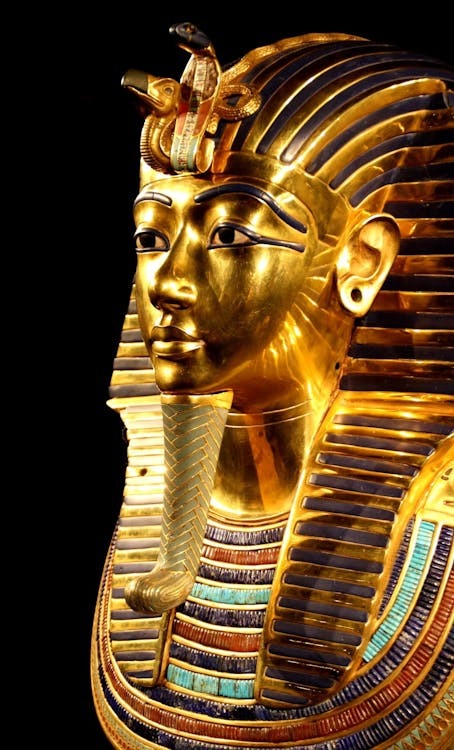
View On WordPress
#archaeological mysteries#Curse of the Pharaohs#Egyptian Pharaohs#Howard Carter#Tutankhamun&039;s tomb
0 notes
Text
The Haunted Mysteries of Egypt's Valley of the Kings
In the mysterious Valley of the Kings, among the tombs of Pharaohs and their Queens, it is said that some are still lingering. Visitors claim to have seen a spectral figure on horse as well as the infamous curse of the tomb of Tutankhamun still linger
In the mysterious Valley of the Kings, among the tombs of Pharaohs and their Queens, it is said that some are still lingering. Visitors claim to have seen a spectral figure on horse as well as the infamous curse of the tomb of Tutankhamun still haunts the empty graves.
The Valley of the Kings in Egypt along the Nile’s western bank, is renowned for its regal tombs and the treasures they hold.…
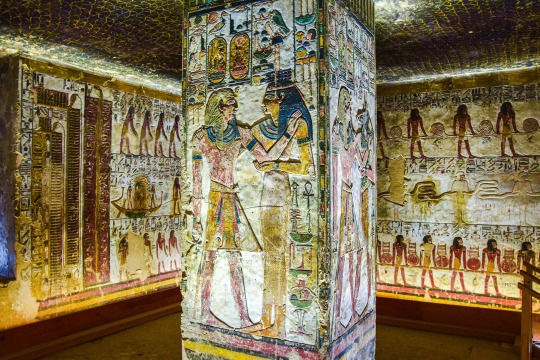
View On WordPress
2 notes
·
View notes
Text
Tutankhamun's tomb is not inscribed with a curse on those who disturb it. This was a media invention of 20th-century tabloid journalists.[248]

1 note
·
View note
Text
It's been 100 years since the discovery of Tutankhamun's tomb!
🎊Hooray for the anniversary!🎊
#tutankhamun#tutankhanun's tomb#and following curse#yey for history#history#egyptology#ancient egypt
1 note
·
View note
Text
Creepy History: The Curse of the Pharaohs (Tutankhamun Edition)
Creepy History: The Curse of the Pharaohs (Tutankhamun Edition)
Mummies have fascinated popular imagination since the days of their earliest discoveries. Fictionalised accounts of mummies coming back to life have been a staple of the horror genre since 1827 with the publication of ‘The Mummy! A Tale of the 22nd Century’ in which the mummy of Cheops (an actual Egyptian pharaoh) was reanimated. Unlike the shambling undead horrors that stalk and terrorise the…

View On WordPress
0 notes